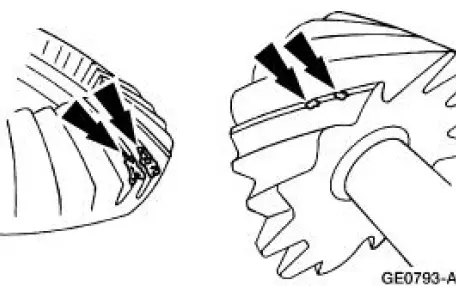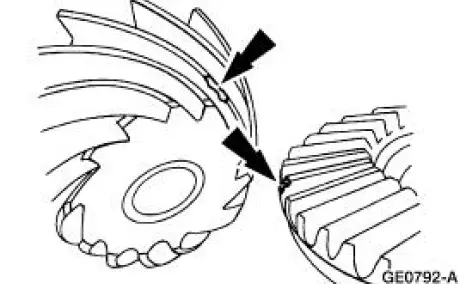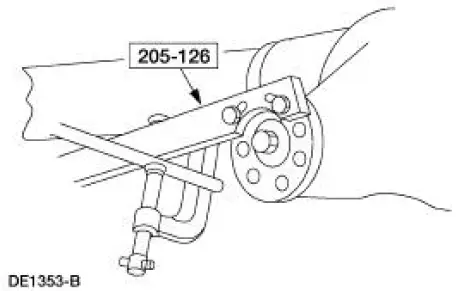Ford Mustang (1999-2004) Service Manual: Knock
Knock, which can occur on all driving phases, has several causes including damaged teeth or gearset.

In most cases, one of the following conditions will occur:
1. A gear tooth damaged on the drive side is a common cause of the knock. This can usually be corrected by grinding the damaged area.

2. NOTE: Measure the end play with a Dial Indicator with Bracketry and not by feel.
Knock is also caused by excessive end play in the axle shafts. Up to 0.762 mm (0.030 inch) is allowed in semi-float axles. The frequency of the knock will be less because the axle shaft speed is slower than the driveshaft.
Clunk
Clunk is a metallic noise heard when the automatic transmission is engaged in REVERSE or DRIVE.
The noise may also occur when throttle is applied or released. It is caused by backlash somewhere in the driveline or loose suspension components; it is felt or heard in the axle. Refer to Total Backlash Check in this section.
Additionally, clunk may be heard upon initial drive-away. This occurs as engine torque shifts vehicle weight, forcing changes in driveline angles, preventing the driveshaft slip-yoke from sliding on the output shaft. To correct for this condition, lubricate the slip-yoke splines.
Total Backlash Check
1. Raise and support the vehicle.
2. Remove the driveshaft.
3. Install the special tool.
- Clamp a rigid bar or pipe to the tool. Clamp the other end of the bar or pipe to the frame or a body member in order to prevent movement of the rear axle pinion flange.

4. Lower the vehicle so that one rear wheel is resting on a wheel chock to prevent it from turning.
The other rear wheel will be used to measure total rear axle backlash.
5. Rotate the free wheel slowly, by hand, until the feeling of driving the rear axle is encountered.
Place a mark on the side of the tire, 305 mm (12 inches) from the center of the wheel, with a crayon or chalk.
6. While holding the crayon or chalk against the tire, rotate the wheel slowly in the opposite direction until the feeling of driving the rear axle is encountered again.
7. Measure the length of the crayon or chalk mark on the tire.
- If the length of the mark is 25.4 mm (1 inch) or less, the rear axle backlash is within allowable limits.
- If the chalk mark is greater than 25.4 mm (1 inch), check for these conditions:
- Elongation of the differential pinion shaft and holes in the differential case (4204).
- Missing differential pinion thrust washer (4230) or differential side gear thrust washer (4228).
- Galling of the differential pinion shaft (4211) and bore.
- Excessive ring gear and pinion backlash. Follow the procedure for the type of rear axle to check backlash.
Axle Shaft Bearing Noise
Axle bearing shaft noise is similar to gear noise and differential pinion bearing whine. Axle shaft bearing noise will usually distinguish itself from gear noise by occurring in all driving modes (drive, coast, and float), and will persist with the transmission in NEUTRAL while the vehicle is moving at the speed in which the concern is occurring. If the vehicle makes this noise, remove the suspect axle shaft, install a new bearing and a new axle seal. Re-evaluate the vehicle for noise before removing any internal components.
Bearing Rumble
Bearing rumble sounds like marbles being tumbled. This condition is usually caused by a worn/damaged wheel bearing. The lower pitch is because the wheel bearing turns at only about onethird of the driveshaft speed. Wheel bearing noise also may be high-pitched, similar to gear noise, but will be evident in all four driving modes.
 Chuckle
Chuckle
Chuckle that occurs on the coast driving phase is usually caused by excessive
clearance between the
differential gear hub and the differential case bore.
Damage to a gear tooth on the coast side can ...
 Symptom Chart
Symptom Chart
Condition
Possible Sources
Action
Traction-Lok
does not work in
snow, mud or on
ice
Differential.
CARRY OUT the Traction-
Lok Differenti ...
Other materials:
Retractor - Rear Seat Safety Belt, Convertible
Special Tool(s)
Torx Bit, Safety Belt Bolt
501-010 (T77L-2100-A)
Removal
1. Remove the rear seat cushion.
2. Remove the luggage compartment front lining board (45444).
3. Release the safety belt guide.
4. Using the special tool, remove the ...
Removal
WARNING: Always wear safety glasses when repairing an air bag
supplemental restraint
system (SRS) vehicle and when handling an air bag module. This will
reduce the risk of injury
in the event of an accidental deployment.
WARNING: Carry a live air ...
Installation
1. Apply silicone gasket and sealant in the locations shown.
2. Install the engine front cover.
3. Install the belt idler pulleys and the bolts.
4. Connect the CMP sensor electrical connector.
5. Raise the vehicle.
6. Install the crankshaft fr ...
